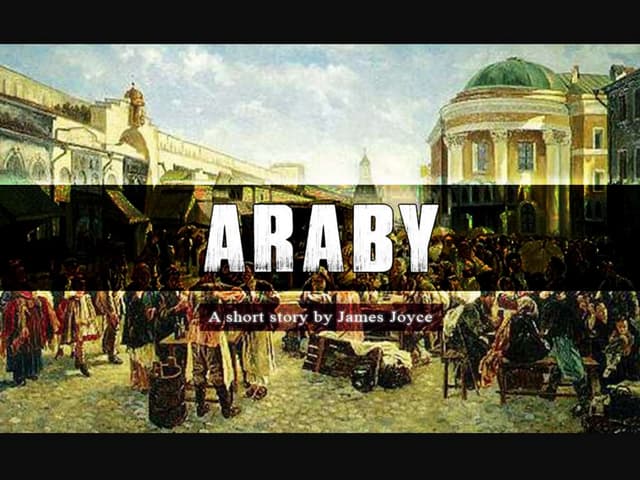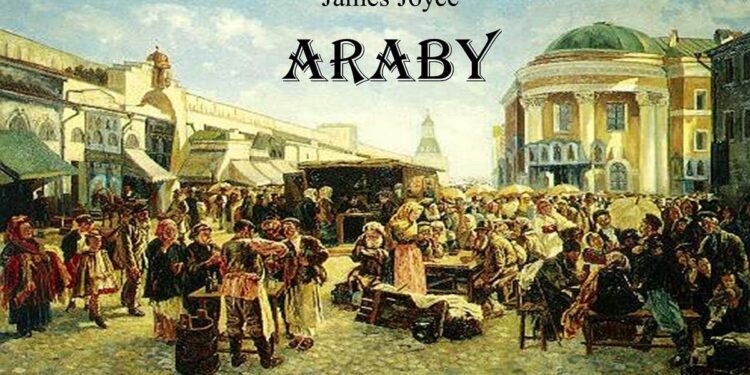Table of Contents
ToggleIntroduction
Araby Summary And Themes By James Joyce Araby, a short story from James Joyce’s collection Dubliners, first published in 1914, is one of Joyce’s most celebrated works, renowned for its exploration of adolescent longing, disillusionment, and the complexities of human desire. The story is told from the perspective of an unnamed boy in Dublin, Ireland, and centers around his infatuation with a girl, as well as his quest to purchase a gift for her at a local bazaar. However, the story ultimately reveals the boy’s disillusionment with his own idealized fantasies, his first confrontation with the gap between youthful dreams and the reality of the world.
Araby is a story that explores themes of love, disillusionment, and the tension between reality and idealism. It also examines the socio-economic conditions of Dublin at the time and the boy’s awakening to the complexities of adulthood, as Joyce subtly critiques the limitations of both individual dreams and societal constraints.Araby Summary And Themes By James Joyce
Summary of Araby
Araby begins with a description of the narrator’s life in a working-class neighborhood in Dublin. The boy lives with his aunt and uncle in a house that once belonged to his deceased parents. His everyday life is mundane, punctuated by a dull routine. He is fascinated by a girl who lives on his street, Mangan’s sister, with whom he has developed an intense infatuation. The boy’s feelings for Mangan’s sister are presented as pure and idealized, and his thoughts are filled with longing and desire to do something meaningful for her.Araby Summary And Themes By James Joyce
One day, Mangan’s sister speaks to him and casually mentions that she wishes she could go to the Araby bazaar, a local fair, but she cannot because of her commitments. The boy immediately decides that he must go to the bazaar to buy a gift for her, feeling that doing so will prove his devotion. This desire to impress her becomes the central driving force of the story. He is eager to make his romantic gesture and win her affection, despite the barriers of distance and time.
The boy’s journey to the bazaar is fraught with delays and obstacles. First, he has to convince his uncle to give him money, which proves to be a challenge as his uncle is preoccupied with other concerns. Eventually, his uncle gives him the money, but by the time the boy arrives at the bazaar, it is late in the evening, and the fair is closing down.
The bazaar, once a symbol of romance and excitement, turns out to be disappointing and desolate. The boy arrives at the entrance just as the lights are dimming and the last few people are leaving. Inside, he encounters a group of apathetic and uninterested vendors, and the exotic and mysterious allure he had imagined the bazaar to hold evaporates in an instant. Instead of finding something that would win Mangan’s sister’s admiration, he is left with a sense of disappointment and self-awareness.
The story ends with the boy standing in the darkened bazaar, filled with a sense of frustration and regret. The idealistic dream of winning the girl’s affection crumbles, and the boy experiences a profound moment of personal growth—a painful recognition of the disparity between the ideal and the real. His search for a transcendent experience ends in disillusionment, marking his first step into the adult world of disappointment and unmet expectations.Araby Summary And Themes By James Joyce

Themes in Araby
- The Conflict Between Idealism and Reality: One of the central themes of Araby is the conflict between the idealized world of youthful fantasy and the harshness of reality. The narrator’s obsession with Mangan’s sister and the bazaar is colored by his romantic and unrealistic expectations. His desire to buy her a gift at the bazaar represents a romantic gesture, an attempt to transcend the mundane and prove his worth. However, the reality of the bazaar, with its dull, lifeless atmosphere, shatters his illusion and exposes the limits of his youthful idealism. The theme of disillusionment is central to the story, highlighting the gap between youthful dreams and the reality of adult life.
Read more
- Youth and the Search for Identity: The story also explores themes of growing up and the search for personal identity. The narrator’s infatuation with Mangan’s sister symbolizes the confusion and intensity of adolescent love. His idealization of her is an expression of his own desire for meaning and purpose, yet it is a desire that is disconnected from the actual person. His journey to the bazaar and the subsequent disillusionment mark a rite of passage, as he begins to realize that the world does not conform to his idealized visions. The story captures the painful and often disillusioning process of coming to terms with the complexities of adulthood.
- The Religious Imagery and Spiritual Longing: Religious imagery is subtly woven throughout Araby, contributing to its exploration of spiritual longing and the search for transcendence. The narrator’s desire to buy the gift for Mangan’s sister is infused with a sense of spiritual devotion, as if he is on a sacred mission. However, his journey to the bazaar, which he perceives as an almost religious pilgrimage, ends in disappointment and a loss of faith. The religious undertones of the story point to the boy’s desire for something greater than the material world, but his experience at the bazaar reveals the futility of seeking meaning in worldly objects.
- The Socio-Economic Environment of Dublin: Joyce’s depiction of Dublin’s working-class neighborhood highlights the socio-economic constraints that shape the boy’s life and worldview. The boy’s family lives in a modest home, and his uncle’s casual neglect suggests the financial struggles that dominate their existence. The boy’s infatuation with Mangan’s sister and his quest for a gift at the bazaar reflect the limitations of his social and economic circumstances. The bazaar itself, with its dimming lights and unenthusiastic vendors, can be seen as a metaphor for the suffocating environment in which the boy lives—a world that does not live up to the romantic ideals he holds.
- The Loss of Innocence: Araby is also a story about the loss of innocence. The narrator’s idealistic view of the world, his romantic dreams, and his sense of youthful excitement are all shattered by the reality of the bazaar. This marks a moment of personal growth, but also a painful loss of innocence as he confronts the adult world of disappointment and unfulfilled desires. His journey to the bazaar symbolizes the transition from childhood to adulthood, where the idealistic fantasies of youth are replaced by a more sober, realistic understanding of life.Araby Summary And Themes By James Joyce
Read more
Literary Techniques in Araby
- First-Person Narration: The story is narrated in the first person, which allows readers to gain direct access to the narrator’s thoughts and emotions. This creates a strong sense of intimacy and immediacy, making the boy’s disillusionment all the more poignant. The first-person perspective also helps to convey the narrator’s internal conflict and his growing awareness of the gap between his dreams and the real world.
- Symbolism: Joyce uses symbolism throughout Araby to deepen the story’s themes. The bazaar itself is a symbol of the boy’s idealized vision of love and transcendence. Initially, the bazaar represents the boy’s hopes and desires, but it eventually becomes a symbol of disillusionment and the failure of those desires. The darkness of the bazaar, the dimming lights, and the indifferent vendors all symbolize the fading of the boy’s youthful dreams.
- Imagery: Joyce employs vivid imagery to evoke the atmosphere of the boy’s world and his emotional state. The descriptions of the dull streets, the cold and lifeless interior of the bazaar, and the girl’s image as an unattainable ideal all contribute to the story’s mood of melancholy and yearning. The imagery also contrasts the narrator’s idealistic vision with the harsh reality he encounters.Araby Summary And Themes By James Joyce
- Irony: Araby is filled with irony, particularly in the way the boy’s expectations are undermined by the reality of the bazaar. The boy imagines the bazaar as a place of romance and excitement, but it turns out to be dreary and disappointing. This irony highlights the theme of disillusionment and serves as a critique of the boy’s naïve understanding of love and the world.

Conclusion
James Joyce’s Araby is a rich and poignant story about the intersection of idealism and reality. Through the boy’s journey to the bazaar, Joyce explores themes of love, disillusionment, and the painful process of growing up. The story captures the intense emotions of adolescence—the longing, the fantasy, and the inevitable confrontation with the limitations of reality.Araby Summary And Themes By James Joyce
Ultimately, Araby serves as a meditation on the transition from childhood innocence to the sobering realization of adulthood, making it one of Joyce’s most celebrated works.Araby Summary And Themes By James Joyce
Read more
(FAQ)
1. What is the significance of the title Araby?
The title Araby refers to a local bazaar that the narrator believes will be a place of exoticism and romantic excitement. However, the bazaar is a place of disappointment, symbolizing the contrast between youthful idealism and the harsh realities of life.
2. How does the story Araby reflect the theme of disillusionment?
The theme of disillusionment is central to Araby. The narrator’s romanticized view of the bazaar and his idealization of Mangan’s sister are shattered when he encounters the mundane and disappointing reality of the bazaar, marking his transition from youthful fantasy to a more sobering understanding of the world.
3. How does Joyce use religious imagery in Araby?
Joyce uses religious imagery to emphasize the narrator’s spiritual longing and idealization of Mangan’s sister. The boy views his mission to the bazaar as a sacred pilgrimage, but his disillusionment at the end of the story suggests a loss of faith in both the girl and the world.
4. What role does the socio-economic setting play in the story?
The socio-economic setting of Dublin, marked by poverty and social constraints, shapes the boy’s worldview. His modest background and the bleakness of the neighborhood contribute to the story’s overall theme of the limitations imposed by society and class.
5. What is the significance of the boy’s final epiphany?
The boy’s final realization is a moment of personal growth, where he confronts the gap between his idealistic dreams and the disappointing reality. It marks a painful but important step in his transition to adulthood.
Read more

















